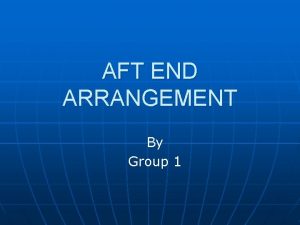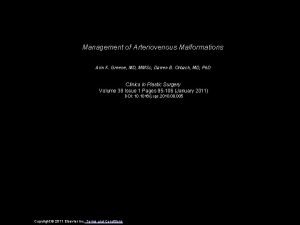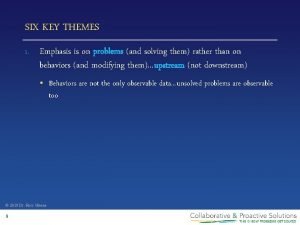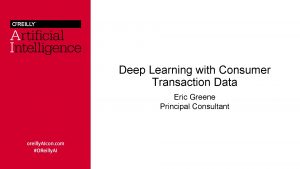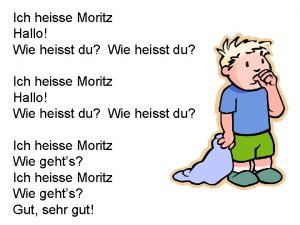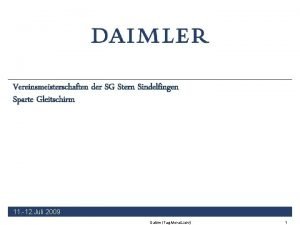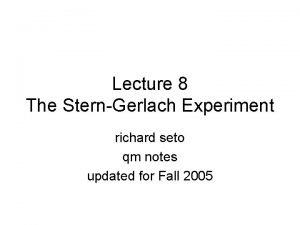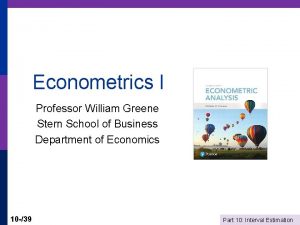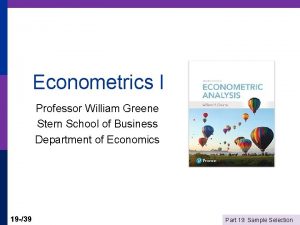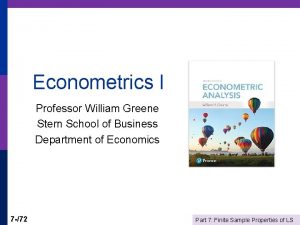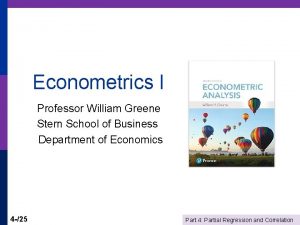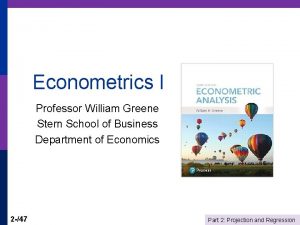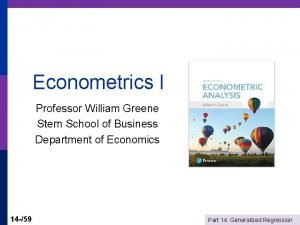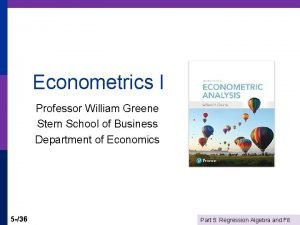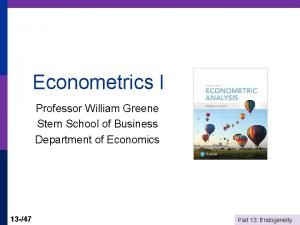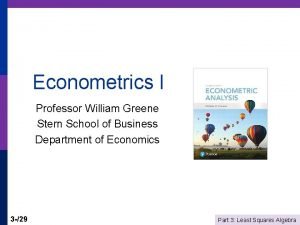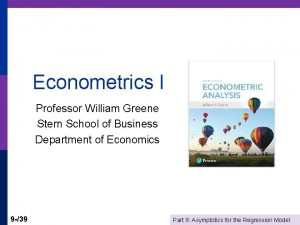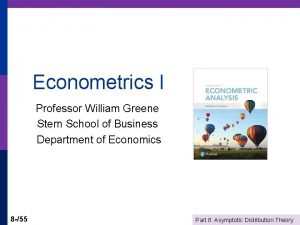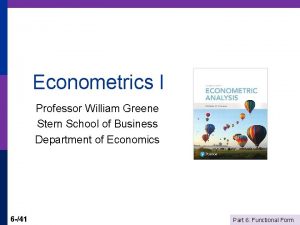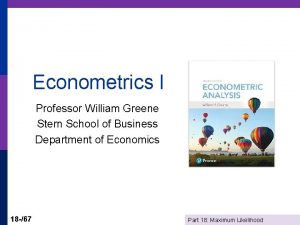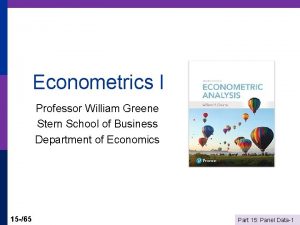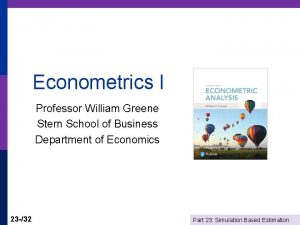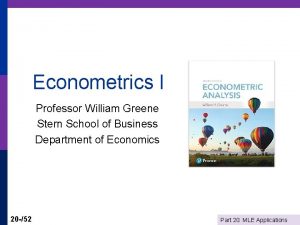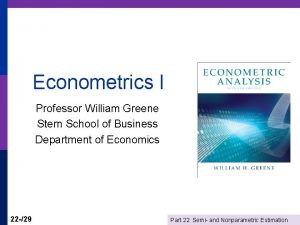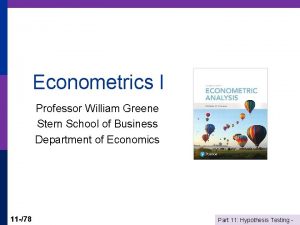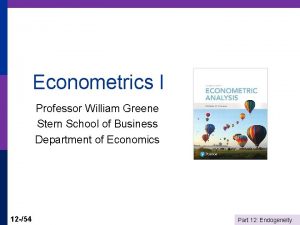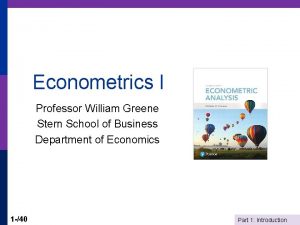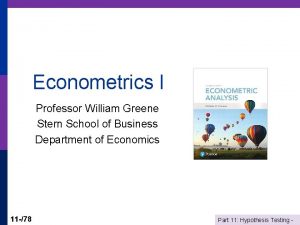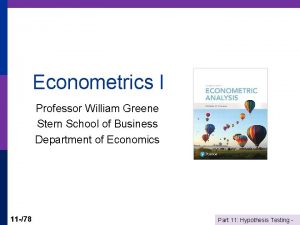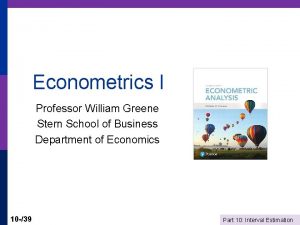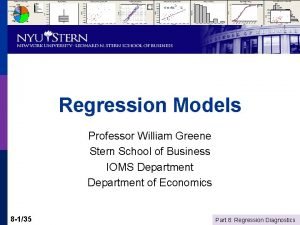Econometrics I Professor William Greene Stern School of



































- Slides: 35

Econometrics I Professor William Greene Stern School of Business Department of Economics 24 -/35 Part 24: Bayesian Estimation

Econometrics I Part 24 – Bayesian Estimation 24 -/35 Part 24: Bayesian Estimation

Bayesian Estimators “Random Parameters” vs. Randomly Distributed Parameters p Models of Individual Heterogeneity p n n 24 -3/35 Random Effects: Consumer Brand Choice Fixed Effects: Hospital Costs Part 24: Bayesian Estimation

Bayesian Estimation Specification of conditional likelihood: f(data | parameters) p Specification of priors: g(parameters) p Posterior density of parameters: p p Posterior mean = E[parameters|data] 24 -4/35 Part 24: Bayesian Estimation

The Marginal Density for the Data is Irrelevant 24 -5/35 Part 24: Bayesian Estimation

Computing Bayesian Estimators p First generation: Do the integration (math) p Contemporary - Simulation: n n 24 -6/35 (1) Deduce the posterior (2) Draw random samples of draws from the posterior and compute the sample means and variances of the samples. (Relies on the law of large numbers. ) Part 24: Bayesian Estimation

Modeling Issues p p As n , the likelihood dominates and the prior disappears Bayesian and Classical MLE converge. (Needs the mode of the posterior to converge to the mean. ) Priors n n 24 -7/35 Diffuse large variances imply little prior information. (NONINFORMATIVE) INFORMATIVE priors – finite variances that appear in the posterior. “Taints” any final results. Part 24: Bayesian Estimation

A Practical Problem 24 -8/35 Part 24: Bayesian Estimation

A Solution to the Sampling Problem 24 -9/35 Part 24: Bayesian Estimation

The Gibbs Sampler p p Target: Sample from marginals of f(x 1, x 2) = joint distribution Joint distribution is unknown or it is not possible to sample from the joint distribution. Assumed: f(x 1|x 2) and f(x 2|x 1) both known and samples can be drawn from both. Gibbs sampling: Obtain one draw from x 1, x 2 by many cycles between x 1|x 2 and x 2|x 1. n n n p Start x 1, 0 anywhere in the right range. Draw x 2, 0 from x 2|x 1, 0. Return to x 1, 1 from x 1|x 2, 0 and so on. Several thousand cycles produces the draws Discard the first several thousand to avoid initial conditions. (Burn in) Average the draws to estimate the marginal means. 24 -10/35 Part 24: Bayesian Estimation

Bivariate Normal Sampling 24 -11/35 Part 24: Bayesian Estimation

Gibbs Sampling for the Linear Regression Model 24 -12/35 Part 24: Bayesian Estimation

Application – the Probit Model 24 -13/35 Part 24: Bayesian Estimation

Gibbs Sampling for the Probit Model 24 -14/35 Part 24: Bayesian Estimation

Generating Random Draws from f(X) 24 -15/35 Part 24: Bayesian Estimation

? Generate raw data Calc ; Ran(13579) $ Sample ; 1 - 250 $ Create ; x 1 = rnn(0, 1) ; x 2 = rnn(0, 1) $ Create ; ys =. 2 +. 5*x 1 -. 5*x 2 + rnn(0, 1) ; y = ys > 0 $ Namelist; x = one, x 1, x 2$ Matrix ; xxi = <x’x> $ Calc ; Rep = 200 ; Ri = 1/(Rep-25)$ ? Starting values and accumulate mean and variance matrices Matrix ; beta=[0/0/0] ; bbar=init(3, 1, 0); bv=init(3, 3, 0)$$ Proc = gibbs $ Markov Chain – Monte Carlo iterations Do for ; simulate ; r =1, Rep $ ? ------- [ Sample y* | beta ] -------------Create ; mui = x'beta ; f = rnu(0, 1) ; if(y=1) ysg = mui + inp(1 -(1 -f)*phi( mui)); (else) ysg = mui + inp( f *phi(-mui)) $ ? ------- [ Sample beta | y*] -------------Matrix ; mb = xxi*x'ysg ; beta = rndm(mb, xxi) $ ? ------- [ Sum posterior mean and variance. Discard burn in. ] Matrix ; if[r > 25] ; bbar=bbar+beta ; bv=bv+beta*beta'$ Enddo ; simulate $ Endproc $ Execute ; Proc = Gibbs $ Matrix ; bbar=ri*bbar ; bv=ri*bv-bbar*bbar' $ Probit ; lhs = y ; rhs = x $ Matrix ; Stat(bbar, bv, x) $ 24 -16/35 Part 24: Bayesian Estimation

Example: Probit MLE vs. Gibbs --> Matrix ; Stat(bbar, bv); Stat(b, varb) $ +--------------------------+ |Number of observations in current sample = 1000 | |Number of parameters computed here = 3 | |Number of degrees of freedom = 997 | +--------------------------+ +--------------+--------+---------+ |Variable | Coefficient | Standard Error |b/St. Er. |P[|Z|>z] | +--------------+--------+---------+ BBAR_1. 21483281. 05076663 4. 232. 0000 BBAR_2. 40815611. 04779292 8. 540. 0000 BBAR_3 -. 49692480. 04508507 -11. 022. 0000 +--------------+--------+---------+ |Variable | Coefficient | Standard Error |b/St. Er. |P[|Z|>z] | +--------------+--------+---------+ B_1. 22696546. 04276520 5. 307. 0000 B_2. 40038880. 04671773 8. 570. 0000 B_3 -. 50012787. 04705345 -10. 629. 0000 24 -17/35 Part 24: Bayesian Estimation

A Random Effects Approach p Allenby and Rossi, “Marketing Models of Consumer Heterogeneity” n n n p Discrete Choice Model – Brand Choice “Hierarchical Bayes” Multinomial Probit Panel Data: Purchases of 4 brands of Ketchup 24 -18/35 Part 24: Bayesian Estimation

Structure 24 -19/35 Part 24: Bayesian Estimation

Bayesian Priors 24 -20/35 Part 24: Bayesian Estimation

Bayesian Estimator Joint Posterior= p Integral does not exist in closed form. p Estimate by random samples from the joint posterior. p Full joint posterior is not known, so not possible to sample from the joint posterior. p 24 -21/35 Part 24: Bayesian Estimation

Gibbs Cycles for the MNP Model p Samples from the marginal posteriors 24 -22/35 Part 24: Bayesian Estimation

Results p p Individual parameter vectors and disturbance variances Individual estimates of choice probabilities The same as the “random parameters model” with slightly different weights. Allenby and Rossi call the classical method an “approximate Bayesian” approach. n n (Greene calls the Bayesian estimator an “approximate random parameters model”) Who’s right? p p 24 -23/35 Bayesian layers on implausible uninformative priors and calls the maximum likelihood results “exact” Bayesian estimators Classical is strongly parametric and a slave to the distributional assumptions. Bayesian is even more strongly parametric than classical. Neither is right – Both are right. Part 24: Bayesian Estimation

Comparison of Maximum Simulated Likelihood and Hierarchical Bayes p p Ken Train: “A Comparison of Hierarchical Bayes and Maximum Simulated Likelihood for Mixed Logit” Mixed Logit 24 -24/35 Part 24: Bayesian Estimation

Stochastic Structure – Conditional Likelihood Note individual specific parameter vector, i 24 -25/35 Part 24: Bayesian Estimation

Classical Approach 24 -26/35 Part 24: Bayesian Estimation

Bayesian Approach – Gibbs Sampling and Metropolis-Hastings 24 -27/35 Part 24: Bayesian Estimation

Gibbs Sampling from Posteriors: b 24 -28/35 Part 24: Bayesian Estimation

Gibbs Sampling from Posteriors: Ω 24 -29/35 Part 24: Bayesian Estimation

Gibbs Sampling from Posteriors: i 24 -30/35 Part 24: Bayesian Estimation

Metropolis – Hastings Method 24 -31/35 Part 24: Bayesian Estimation

Metropolis Hastings: A Draw of i 24 -32/35 Part 24: Bayesian Estimation

Application: Energy Suppliers N=361 individuals, 2 to 12 hypothetical suppliers p X= (1) fixed rates, (2) contract length, (3) local (0, 1), (4) well known company (0, 1), (5) offer TOD rates (0, 1), (6) offer seasonal rates (0, 1). p 24 -33/35 Part 24: Bayesian Estimation

Estimates: Mean of Individual i MSL Estimate Bayes Posterior Mean Price -1. 04 (0. 396) -1. 04 (0. 0374) Contract -0. 208 (0. 0240) -0. 194 (0. 0224) Local 2. 40 (0. 127) 2. 41 (0. 140) Well Known 1. 74 (0. 0927) 1. 71 (0. 100) TOD -9. 94 (0. 337) -10. 0 (0. 315) Seasonal -10. 2 (0. 333) -10. 2 (0. 310) 24 -34/35 Part 24: Bayesian Estimation

Reconciliation: A Theorem (Bernstein-Von Mises) p p p The posterior distribution converges to normal with covariance matrix equal to 1/n times the information matrix (same as classical MLE). (The distribution that is converging is the posterior, not the sampling distribution of the estimator of the posterior mean. ) The posterior mean (empirical) converges to the mode of the likelihood function. Same as the MLE. A proper prior disappears asymptotically. Asymptotic sampling distribution of the posterior mean is the same as that of the MLE. 24 -35/35 Part 24: Bayesian Estimation
 Aft end construction of ship
Aft end construction of ship Promotion from associate professor to professor
Promotion from associate professor to professor Kylie greene
Kylie greene The tenth man graham greene summary
The tenth man graham greene summary Green to stokes
Green to stokes Graham greene destructors
Graham greene destructors Adaptive challenges examples
Adaptive challenges examples Heart of darkness
Heart of darkness Robert greene shakespeare
Robert greene shakespeare Arin greene
Arin greene Linda r greene
Linda r greene Livesinthebalance alsup
Livesinthebalance alsup Ross greene plan a b c
Ross greene plan a b c Maxine greene releasing the imagination
Maxine greene releasing the imagination Ericka simpson md
Ericka simpson md Eric greene course
Eric greene course Auditory digital
Auditory digital Uzuri pease-greene
Uzuri pease-greene Jody greene ucsc
Jody greene ucsc Margaret mahler utvecklingsteori
Margaret mahler utvecklingsteori Stern village trumbull ct
Stern village trumbull ct Stern of a vessel
Stern of a vessel Dr theodore stern
Dr theodore stern Fantail of ship
Fantail of ship Experimento stern-gerlach
Experimento stern-gerlach Bow stern port starboard
Bow stern port starboard Dr brian stern
Dr brian stern Hallo wie heiße ich
Hallo wie heiße ich Ady stern
Ady stern Daniel stern model
Daniel stern model Sg stern sindelfingen sindelfingen
Sg stern sindelfingen sindelfingen Howard stern allison
Howard stern allison Itshak stern
Itshak stern Ben kingsley som itzak stern
Ben kingsley som itzak stern Stern-gerlach experiment lecture notes
Stern-gerlach experiment lecture notes Stern teoria
Stern teoria
